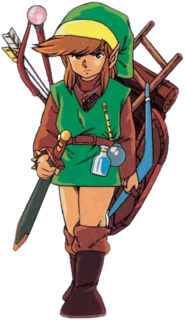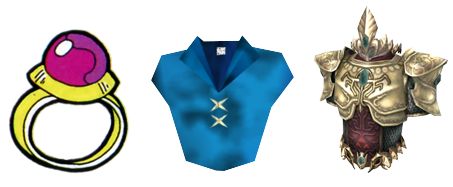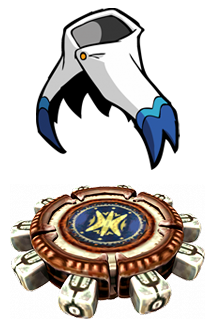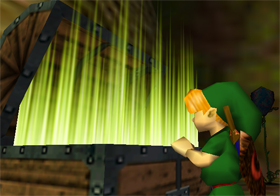The Evolution of Link’s Equipment
Posted on April 08 2011 by Djinn
 A fundamental aspect of the Zelda series starting with the very first game in 1986 was the acquisition and use of various items and weapons to help Link in his quest to defeat Ganon, rescue the princess, and save Hyrule. Instead of beginning the first game with a sword in hand, Link begins with absolutely nothing. He acquires his sword from a mysterious old man in a nearby cave. This shows players that discovering secrets and obtaining items from them is the main characteristic of the game and entices them to search for more. Over the course of the adventure Link gains a small arsenal of items which all prove useful in some way. Link uses these items to combat the insurmountable odds against him, open up new areas for exploration, and to move the story forward. As the technology behind the games evolved, allowing for better controls and adding new styles of gameplay, the equipment Link carried had to evolve with it. Sometimes this was done to create a greater challenge by adding more limits to items’ usage, increasing opportunities for puzzles (as with the Ocarina of Time and Lens of Truth), or creating more potential for exploration (as with the hookshot). Simply defeating more enemies and raising defense was no longer the goal; a greater challenge no longer meant defeating more enemies in a single room, but overcoming an environment or complex puzzle in three dimensions. The transition to the N64 gave players precision aiming with the bow and a more complex method of combat through Z-targeting. The use of the touchscreen and the wiimote in newer Zelda titles allowed for an even greater interactive experience for players and more options beyond compulsive button mashing of the past.
A fundamental aspect of the Zelda series starting with the very first game in 1986 was the acquisition and use of various items and weapons to help Link in his quest to defeat Ganon, rescue the princess, and save Hyrule. Instead of beginning the first game with a sword in hand, Link begins with absolutely nothing. He acquires his sword from a mysterious old man in a nearby cave. This shows players that discovering secrets and obtaining items from them is the main characteristic of the game and entices them to search for more. Over the course of the adventure Link gains a small arsenal of items which all prove useful in some way. Link uses these items to combat the insurmountable odds against him, open up new areas for exploration, and to move the story forward. As the technology behind the games evolved, allowing for better controls and adding new styles of gameplay, the equipment Link carried had to evolve with it. Sometimes this was done to create a greater challenge by adding more limits to items’ usage, increasing opportunities for puzzles (as with the Ocarina of Time and Lens of Truth), or creating more potential for exploration (as with the hookshot). Simply defeating more enemies and raising defense was no longer the goal; a greater challenge no longer meant defeating more enemies in a single room, but overcoming an environment or complex puzzle in three dimensions. The transition to the N64 gave players precision aiming with the bow and a more complex method of combat through Z-targeting. The use of the touchscreen and the wiimote in newer Zelda titles allowed for an even greater interactive experience for players and more options beyond compulsive button mashing of the past.
Much of Link’s equipment in the original Legend of Zelda was used for combat, some even replacing the sword in utility. While it did have its share of limited-use items, they were often replaced by something more useful. The blue candle, which could only be used once per screen, was eventually replaced by the red candle, which can be used as many times as the player wishes. The slow and short-ranged boomerang was replaced by the magical boomerang, which had a much longer range. Even the less impressive step ladder was invaluable in crossing the many rivers in the overworld or lava in the underworld, providing a much faster method of travel for Link and allowing him to avoid many holes and obstacles in his path. In later games Link required other similar magical items such as the Roc’s Feather to travel across holes in his path. The items found later in The Legend of Zelda, such as the magical key and the magic rod, were limitless in their use. They had no heart, money, or magic requirements. The magic book actually upgraded the already useful magic rod even more, providing Link with a very powerful item that had endless uses in the overworld and underworld. This was one of the few games in the series to provide unlimited use items such as these while not affecting game difficulty.
Adventure of Link changed the item system and how items were used. They no longer provided a secondary method of attack, nor could the player choose to open an inventory screen and use them at any time. They were changed from inventory items to one time only quest items needed to open a certain area for exploration or unlock a pathway to continue the game. Their utility in combat and in dungeons was replaced by the magic system, forcing the player to rely on newly acquired sword skills and learned spells to aid them throughout the game. More emphasis was placed on the magic meter for amount of time a spell could be used, and the level system instead of heart and sword upgrades.
When A Link to the Past was released, the developers at Nintendo decided to return to the original top-down view and item-based system of combat and exploration of the original Legend of Zelda. The better controls and easier quest required that a few limitations needed to be placed on some of the weapons. The magic meter from Adventure of Link provided this necessary limit on the amount of times a magic weapon could be used, while a few items returned with appropriate updates. The magic rod was replaced by the fire and ice rods, the hammer of Adventure of Link returned as a usable item in your inventory, although limited in its use, while the flute gave the player the ability to actively choose the location they would be transported to. A simple flame could no longer light a room indefinitely as it did in the original Zelda, nor could it in any random location. Torches and special pots were added for Link to light the darkened rooms, but they often go out and require relighting after a fixed amount of time had passed. For this a lantern was provided which also required the magic meter. This limited its use, but could still light torches temporarily, allowing Link to prevent excessive magic meter consumption.

When the Zelda series moved to 3D, even more restrictions were added to the items, possibly to increase the level of challenge as the shift to a 3D environment allows for more movement in more vectors than the basic cardinal directions of up, down, left, and right. Since much more emphasis was placed on close range engagements with the sword and shield using a target system, long range shooting weapons would make the adventure far too easy for players. So the restrictions of magic meter and ammunition remained while also adding the extra element of aiming in a 3D environment. Since special arrows now drained both the magic meter and the number of arrows in your inventory, many players were a little less willing to use these weapons unless they were absolutely necessary. No longer was the bow and arrow an extra weapon to be used out in the overworld for enjoyment but they became commodities to be held onto until a specific situation called for them to be used. The fire and ice rods of A Link to the Past only required that Link be in a line of sight from an enemy. Now the Fire and ice arrows required precision aim, providing more difficulty. The Red and Blue tunics of Ocarina of Time no longer provided that extra defense that the red and blue tunics of A Link to the Past and rings of The Legend of Zelda once provided. They now had more environment related purposes by protecting Link from various conditions such as the heat of a fiery volcano or the lack of air in an underwater temple.
Many other items in Link’s inventory also lost their uses in the overworld and became plot devices for unlocking other areas, either by moving the story along through interaction with NPC’s, or signifying that an area had been completed. At first, such items were rare but their numbers have been steadily growing over the years. The letter from the old man of the original Zelda was an interesting addition and added a small element of story to the game, while the accessories of Adventure of Link were not as important as usable items since magic had taken their place in the game. Even more inventory items were seen in A Link to the Past but they were still few in number, while the items Link did collect were useful enough that it was not noticeable. Ocarina of Time, Majora’s Mask, and The Wind Waker added a whole section of the inventory screen dedicated to these sorts of items. Quest items like the spiritual stones and the Sage Medallions have been seen in the past in the form of the Pendants of virtue of A Link to the Past. Even less valuable quest items were added in the form of collectible masks, the letters from various NPCs, the Gerudo membership card, Beedle membership cards, bait, and enemy spoils that only seemed to fill up the empty spaces in the inventory screen. Many were plot devices that had little to do with the overall story, but add a little more character and complexity to the setting. While not an aspect of the main quest or even required to continue the game, items such as joy pendants are frequently used for NPC sidequests or for providing an extra element of gameplay, as seen with the pictobox of Wind Waker or Majora’s Mask. It seems more and more quest items are taking the place of operative weapons as more emphasis is placed on a larger story and interactive surroundings.
 By the time of Twilight Princess the disparity between useful and gimmick accessories was finally noticeable to the point where players were asking themselves “Where have all the good weapons gone?” The removal of the magic meter meant that Link could no longer carry any magical items like the magic rods, medallions, or spells. This also meant the loss of the fire and ice arrows, magical masks, or any past magic consuming items. Twilight Princess also broke tradition as the first 3D game not to feature some form of magical musical instrument important to the overall story. These items were replaced in favor of objects meant to help Link move more easily through dungeons, open more hard to reach areas, and fight the bosses of eachtemple. The ball and chain, spinner, and double claw shot were crucial for passing the dungeons they were discovered in and necessary for combat with the boss of each. They all had few to no uses out in the overworld unless a situation specifically called for it such as certain heart piece caves.
By the time of Twilight Princess the disparity between useful and gimmick accessories was finally noticeable to the point where players were asking themselves “Where have all the good weapons gone?” The removal of the magic meter meant that Link could no longer carry any magical items like the magic rods, medallions, or spells. This also meant the loss of the fire and ice arrows, magical masks, or any past magic consuming items. Twilight Princess also broke tradition as the first 3D game not to feature some form of magical musical instrument important to the overall story. These items were replaced in favor of objects meant to help Link move more easily through dungeons, open more hard to reach areas, and fight the bosses of eachtemple. The ball and chain, spinner, and double claw shot were crucial for passing the dungeons they were discovered in and necessary for combat with the boss of each. They all had few to no uses out in the overworld unless a situation specifically called for it such as certain heart piece caves.
Many of these items are only thought of as useless due to poor implementation. One example is the Dominion Rod, which had many levels of use within the Temple of Time but had no other function outside of the temple other than moving the occasional owl statue essential only for reaching the very next dungeon. If more statues and obstacles were added to the game, providing more puzzles or secrets to be discovered throughout Hyrule just by owning it, then the Dominion Rod would be much more useful. Very few tracks were provided for the Spinner, other than ones left for a heart piece or two in a few random caves. If more tracks, or other things such as vines that could function as tracks were present, then it would also become a much more used item. The Ball and chain may replace the bombs with its ability to break rocks and barriers, but is slow and has poor aim. It cannot be used against enemies due to the slow swing, while few areas outside of the Ice Mansion even required it.
The handheld sequels have maintained the same stylings as A Link to the Past since many of the weapons and equipment are the same, although fewer in number than what we had in the SNES days. A return to 2D allowed for many long lost concepts such as sword beams and a much more user friendly boomerang to be used once more. Emphasis moved from the need for defense and aim to the need to pass obstacles in Link’s path as jumping and climbing were no longer an option. Items like Roc’s Cape, the Sand Wand, and Mole Mitts become necessary tools because the 2D environments called for the need to move rocks, burrow through walls, or simply jump over small holes. Meanwhile, the Nintendo DS had many newer applications that allowed the player to have a much more interactive feel for how items were used. Blowing into the microphone would make use of the Whirlwind or Spirit Flute. The touchscreen controls gave players a better experience in gameplay as the stroke of a stylus was more like the swinging of a sword than just an ordinary press of a button.
Because of the scale of each game, certain items like the bombs or arrows are required to progress. Each game in the series has had its share of useless items but the large amount of content made them less noticeable. In most of the 2D titles the boomerang became the most used secondary item with the greatest utility. It seems that the items won in dungeons have less and less utility to combat the decreasing level of challenge each game brings to the player. In later years the decreasing difficulty of each game required that the weapons Link discovers have more restrictions placed upon them until they became little more than a tool for defeating a boss. A magic rod such as the one from LoZ with no limits to its use would radically alter the level of challenge in any modern 3D Zelda. There would be virtually no need for close range engagements or any need to refill ammunition or the magic meter. Due to the necessity of keeping the difficulty consistent, dungeon items slowly became more of a gimmick for certain specific locations and less of a useful implement for everyday use in the overworld, many losing their usefulness as soon as the player leaves the dungeons
 It appears that the equipment for each game largely depends on the environment of the game, whether it is 2D or 3D, the type of control scheme, and the technology that could allow for a greater interactive experience for the player. In the early titles, players were limited to their own reflexes and judgment against the overwhelming odds and hordes of enemies, so weapons that gave players a greater mode of attack reflected this. As controls and options grew, the limitless abilities of the weapons had to shrink in order to maintain the level of challenge, and again evolve with the shift from two dimensions to three. Developers have to carefully adapt to new advancements in technology to maintain a similar gameplay style to the prequels of past consoles. To manage the balance between challenge, usefulness, and of course fun for the player while maintaining the traditional approach, the equipment Link carries always had to make the greatest noticeable adjustment and will continue to change for better or worse in games to come.
It appears that the equipment for each game largely depends on the environment of the game, whether it is 2D or 3D, the type of control scheme, and the technology that could allow for a greater interactive experience for the player. In the early titles, players were limited to their own reflexes and judgment against the overwhelming odds and hordes of enemies, so weapons that gave players a greater mode of attack reflected this. As controls and options grew, the limitless abilities of the weapons had to shrink in order to maintain the level of challenge, and again evolve with the shift from two dimensions to three. Developers have to carefully adapt to new advancements in technology to maintain a similar gameplay style to the prequels of past consoles. To manage the balance between challenge, usefulness, and of course fun for the player while maintaining the traditional approach, the equipment Link carries always had to make the greatest noticeable adjustment and will continue to change for better or worse in games to come.



